The Illusion of Depth in Stained Glass: Techniques
| The Illusion of Depth in Stained Glass: Techniques |
| Robert Oddy |
 |
| Figure 1: Central New York (1989). You will see that the |
| furrows in the field at the bottom of the panel converge. |
As artists, we need to be aware of how we perceive depth in the real world. I have given much attention to give depth to my own work. In the last issue of Glass Craftsman magazine, Summer 2011, Issue #222, I wrote about achieving an illusion of depth, or three-dimensionality in essentially two-dimensional stained glass panels. I pointed out some of the principles of composition, applicable to most 2-D art media, that give the viewer the impression that she or he is seeing solid objects, or looking into a range of distances. In the earlier article, I listed some clues which we use to judge depth and distance in the world around us, and which we can exploit in our artwork. In this article, I would like to become more specific about how we can achieve depth effects in stained glass work. I will do this by analyzing the 3-D effects in a small selection of my art work.
The clues that I identified earlier are as follows: apparent size of features; perspective and 3-D geometry; nearer objects obscuring parts of further ones; color saturation decreasing with distance; color variation indicating the shape of solid objects; lines becoming less distinct with distance; and simulating focus by careful composition.
Landscape Geometry
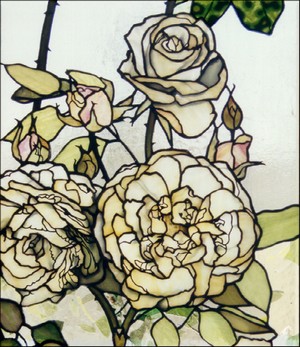 |
| Figure 2: Roses (1998/90) detail |
| Notice how the large blossom stands out. |
In Central New York (see figure 1), the landscape is very simple and stylized. It therefore depends almost entirely on the geometry of the design for its sense of depth or distance. For the moment, ignore the large corn and flowers superimposed on the landscape. You will see that the furrows in the field at the bottom of the panel converge. This gives an impression of perspective, so that we see the field as receding from us.
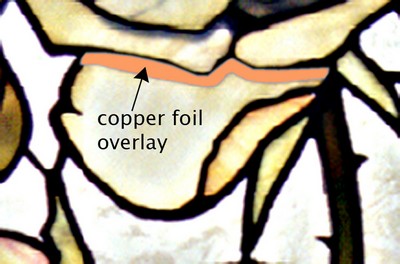 |
| Figure 3: Reverse side of the Bourbon rose, |
| showing copper foil overlay for shadow. |
Also, note that the lines are gently curved, creating the impression that the land undulates a little, i.e. it is not flat, and that we are standing on relatively high ground, looking across a wide, flat valley (a feature typical of the region). The clouds in the sky are also shown in perspective, this time by careful alignment of the streaks in the glass. The wind is blowing the clouds from the distant left towards the right, behind us. So, as you scan across the sky from left to right, the streaks tilt more and more to the right. Most of the sky is made with Spectrum’s white wispy glass, but close to the horizon, I used some clear baroque with finer streaks to give the impression of greater distance.
Flower Arrangement
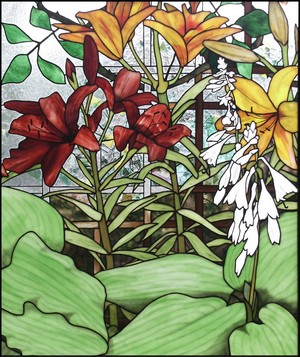 |
| Figure 4: Floral Design #4 |
| (2005), one of four panels. |
Figure 2 shows a small part of a pair of side lights containing ten different types of rose. This one is a Bourbon rose, a variety dating from the early 19th century. Notice how the large blossom stands out. It is obviously in front of other features, such as the bud on the right, the other open blossom on the left, the stems and some of the leaves, because it hides parts of them.
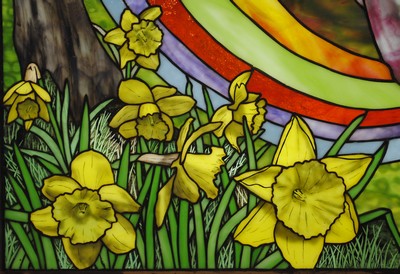 |
| Figure 5: Liturgical Dancer (2011), detail. |
| The daffodils vary considerably in apparent size. |
I have also darkened the blossom to the left, to indicate a shadow cast by the large flower. The yellow glass used for this rose has only a very subtle streakiness, so I have given the flowers depth by using different shades of yellow. Some pieces have a pale grey glass plated on the back to darken them. A narrow shadow, such as the one cast on the lowest petal of the top rose, is produced by overlaying copper foil on the reverse side of the glass (see figure 3).
3-D Forms and Contours
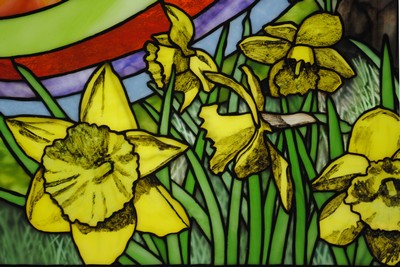 |
| Figure 6: Reverse side of daffodils in |
| Liturgical Dancer, showing painted shading. |
In figure 4, there are several clues to depth. Firstly, the flowers and leaves overlap each other. The background glass in the lower half of the panel is very dark, so that the leaves and stems stand out dimensionally. The hosta leaves have shading painted on the reverse side, and the veins are curved to suggest wrinkles in the leaves’ surfaces. The curves in the edges of the leaves and in some of the lily and hosta petals serve the same purpose.
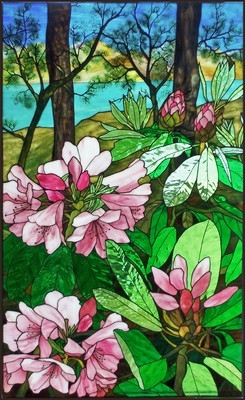 |
| Figure 7: Gable Rhododendron (2009). |
The deeper parts of the lily blossoms are darker red to accentuate the trumpet-like form of the flowers. This is achieved simply by choice of suitable pieces of glass from the sheet. The streaky features in the glass are also exploited to give 3-D shape to the petals. Taking extra time to choose glass deliberately and cut some more complex shapes enhances the illusion of depth.
Color Variation
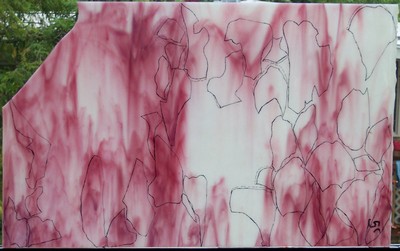 |
| Figure 8: Choose the positioning of the glass carefully |
| as you draw out the petals as in Gable Rhododendron. |
You only see a section of an entire window in figure 5 in order to highlight the use of shadows. I want you to look at the daffodils. They vary considerably in apparent size, so it is clear which are closer to the viewer. Also, they are painted on the reverse side to give the impression of shadows and curvature to the back petals and the trumpets. You can see in figure 6 how crude the painting is! The black paint is diffused through the opalescent yellow glass to produce the more subtle effect apparent in figure 5. A note on painting: on opalescent glass, I usually employ a paint called Liquitex, the “Glossies” series. which is designed for use on glass and ceramics, and cures by baking at 325 degrees F. This is a low temperature, so I don’t have to worry about changes to the colors or density of the glass that often occur at the much higher fusing temperatures.
Feature Near and Far
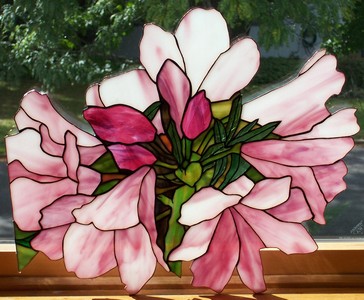 |
| Figure 9: Flowers in Gable Rhododendron |
| before the stamens are attached. |
I used several techniques to give an illusion of depth to the picture of rhododendrons in figure 7. Once again, overlapping the blossoms and leaves in the design give obvious clues to distance in the foreground, and the dark background glass makes the flowers stand out. I used four or five different shades of Spectrum’s waterglass for the leaves. The gentle waves in the glass are used to suggest the veins and undulations of the leathery leaves.
 |
| Figure 10: It is amazing how much the inclusion |
| of stamens enhances the 3-D effect. |
Some leaves are clearly in shadow, while others are exposed to the sunlight. Some leaves look larger than others. The streaks and varying saturation of pink color in the glass are used to give shape to the petals and to give depth to the trumpets. I have found that to make economical use of the glass, I choose glass for every petal and draw all their outlines on the sheet before cutting the glass (see figure 8). It is amazing how much the inclusion of stamens enhances the 3-D effect — see figures 9 and 10. These photos compare one of the trusses with and without stamens.
Diffused Distance
 |
| Figure 11: This illustrates the process of plating ice white |
| stipple glass over the sky and hills in Gable Rhododendron. |
Now, let us turn our attention to the distant landscape in Gable Rhododendron (by the way, Joe Gable was a well-known hybridizer of rhododendrons, and was the grandfather of my client!). The hills in the distance are of muted colors, and the lines defining the far shore of the lake and the hill-tops are very fine and indistinct, as you would expect of very distant features.
 |
| Figure 12: Part of the distant background for Gable |
| Rhododendron, showing very narrow joins by cutting |
| away most of the foil from the surface of the glass. |
This is achieved by plating, that is making multiple layers of glass. In this case, the colors of the sky, hills and lake are in the second layer, and the tree forms are in the top layer, consisting of Youghiogheny’s ice white stipple glass (figure 11). The ice white glass diffuses the lines between sky, hills and lake, and also softens the colors a little. I also made the foil joins in the second layer extremely thin by cutting away most of the foil from the surface of the glass (figure 12). I have simplified the description of this window a little for the purposes of this article. Fabricating this window was an interesting challenge, because it had to be equally effective viewed from both sides, which is difficult with plated panels — more on this another time, perhaps!
Some of the techniques that I have described are applied during the design work, for example: apparent relative sizes of objects; perspective; relative positioning of features including overlaps; and shapes of features to indicate curves and folds in 3-D space. Other techniques are used during fabrication: choice of colors and textures; painting, plating or overlays for shading or suggesting contours; and line thickness or indistinctness. To give a feeling of depth to a flat stained glass panel is to create an illusion. All aspects of the work contribute to this illusion.
web: www.robertoddy.com | mail: artist@RobertOddy.com | phone: (315) 200-2260
